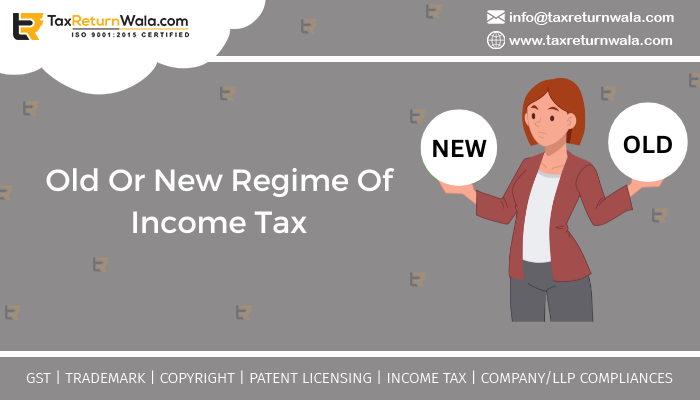Old Or New Regime Of Income Tax?
A new tax regime was introduced by the Government of India in the year 2020 where taxpayers were given an option to either continue with the old tax regime where they can claim tax exemptions or opt for a new tax regime with no tax exemption but low tax rates. There are 2 key differences between these two income tax regimes in India:
Firstly, the new tax regime includes more tax slabs with lower tax rates as compared to the old tax regime.
Secondly, all the major deductions and exemptions such as Section 80C, Section 80D, etc. that are available under the old tax regime are not allowed if you opt for the new tax regime.
There has been a change in slab rates too, let’s understand the slab rates as below:
Given below are the income tax slabs for FY 2022-23 (AY 2023-24) under both tax regimes for resident individuals aged less than 60 years, Hindu Undivided Family (HUF) and Non-Resident Indians (NRI) with income in India:
| Net Taxable Income | Slab under New Tax Regime | Slab under Old Tax Regime |
| Up to Rs 2.5 lakh | Exempt | Exempt |
| Rs 2,50,001 to Rs 5 lakh | 5% | 5% |
| Rs 5,00,001 to Rs 7.5 lakh | 10% | 20% |
| Rs 7,50,001 to Rs 10 lakh | 15% | |
| Rs 10,00,001 to Rs 12.5 lakh | 20% |
30% |
| Rs 12,50,001 to Rs 15 lakh | 25% | |
| Over Rs. 15 lakh | 30% |
Taxpayers with net taxable income exceeding 50 lakhs in the Assessment year 2023-24 i.e. financial year 2022-23, have to pay a surcharge on their income tax computed based on the income tax slab rates for FY 2022-23. The applicable rate of surcharge is as follows for FY 2022-23:
| Net Taxable Income | Rate of Surcharge on Income Tax (%) |
| Rs. 50 lakh to Rs 1 crore | 10 |
| Rs. 1 crore to Rs. 2 crore | 15 |
| Rs. 2 crore to Rs. 5 crore | 25 |
| Rs. 5 crores and above | 37 |
Deductions and Exemptions that are removed in the new regime are given below:
- Leave Travel Allowance
- House Rent Allowance
- Conveyance Allowance
- Daily Expenses while employed
- Relocation Allowance
- Helper Allowance
- Children Education Allowance
- Other Special Allowances
Deductions and Exemptions that are allowed in the new regime are given below:
- Retirement Benefits, Gratuity
- Conveyance Allowance for expenditure incurred for traveling for duties of an office
- Transport Allowance for specially-abled people
- Education Scholarships
- Retrenchment Compensation
- Investment in Notified Pension Scheme under Section 80CCD (2)
- Depreciation u/s 32 of the Income Tax Act except for additional depreciation
Let’s take an example to choose which regime is better – New Regime or the Old regime.
| Basic Salary: Rs. 12,00,000/-
HRA: Rs. 6,00,000/- Special allowance: Rs.2,52,000/- Leave Travel Allowance: Rs.20,000 (Actual – Rs.12000) Rent Paid: Rs. 3,00,000/- |
Interest earned from Savings Account: Rs.12,000
Interest earned from Fixed Deposit: Rs.8,000 PPF: Rs.50,000 ELSS: Rs.20,000 LIC Premium: Rs.9,000 Medical Insurance: Rs.12,000 EPF Contribution: Rs.1,44,000 |
| Particulars | Taxable as per the old regime | Taxable as per the new regime |
| Basic Salary | 12,00,000 | 12,00,000 |
| HRA | 4,20,000 | 6,00,000 |
| Special Allowance | 2,52,000 | 2,52,000 |
| LTA | 8,000 | 20,000
|
| Standard deduction | (50,000) | – |
| GTI from salary | 18,30,000 | 20,72,000 |
DEDUCTIONS THAT ARE AVAILABLE UNDER THE OLD REGIME
| Particulars | Maximum Deduction | Eligible Investment | Amount Claimed |
| Section 80C | Rs. 1,50,000 | PPF Rs. 50,000 +
ELSS Rs. 20,000 + LIC Rs. 9,000 + EPF Rs. 1,44,000 |
Rs. 1,50,000 |
| Section 80D | Rs. 25,000(Self)
Rs. 50,000 (Parents) |
Rs. 12,000 | Rs. 12,000 |
| Section 80TTA | Rs. 10000 | Rs. 8,000 | Rs. 8,000 |
CALCULATION OF GROSS TAXABLE INCOME UNDER THE OLD REGIME
| PARTICULARS | AMOUNT | TOTAL |
| Income from salary | 18,30,000 | |
| Income from other sources | 20,000 | |
| Gross Total Income | 18,50,000 | |
| Deductions | ||
| 80C | 1,50,000 | |
| 80D | 12,000 | |
| 80TTA | 8,000 | (1,70,000) |
| Gross Taxable Income | 16,80,000 | |
| Total Tax on above (including cess) |
3,29,160 |
CALCULATION OF GROSS TAXABLE INCOME UNDER THE NEW REGIME
| PARTICULARS | AMOUNT | TOTAL |
| Income from salary | 20,72,000 | |
| Income from other sources | 20,000 | |
| Gross Taxable Income | 20,92,000 | |
| Total tax on above (including cess) |
3,79,704 |
Thus in the above case, it is better to opt old regime.
Both the new and old slabs have their pros and cons. One tax regime cannot be beneficial for all. Income, its type, Investments, deductions, and exemptions determine which tax regime would give you better tax benefits. It’s better to calculate your tax liability using both regimes and the regime which gives you the lowest tax liability should be chosen depending on your requirement.
For more clarifications and guidance on which tax regime is best as per your income, feel free to contact us at info@taxreturnwala.com


